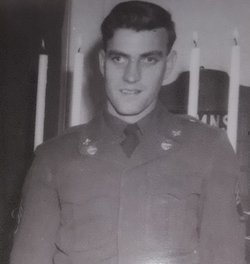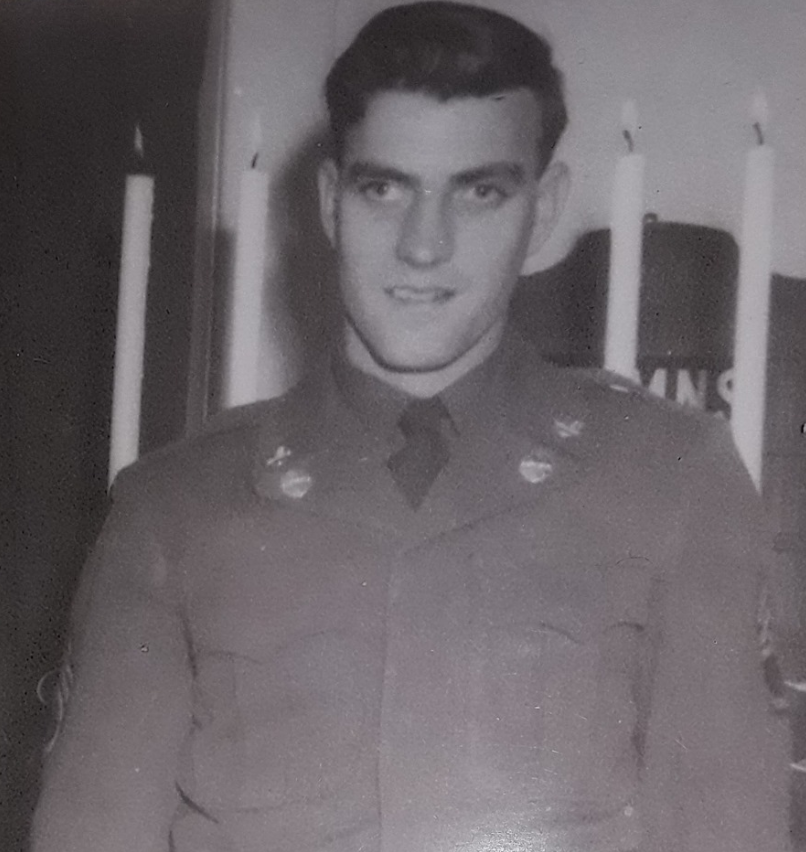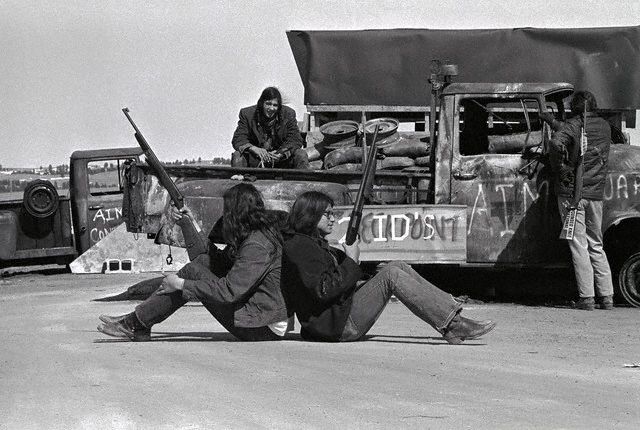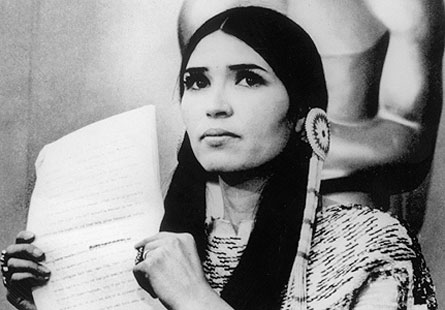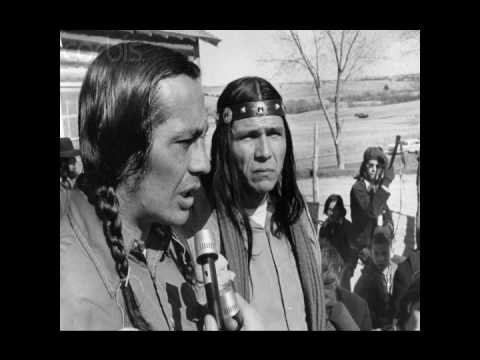The movement and protest was meant to aid the Oglala Sioux (a.k.a. Oglala Lakota) of the nearby Pine Ridge Reservation, and to gain media coverage; unhappy and at-risk members of the Sioux asked a fairly powerful Native American movement named AIM to help protest federal government treatment and indifference of/to the reservation, as well as corruption and violence against "enemies" of the current leadership and tribal chief at Pine Ridge.
The area at the former tragic location of Wounded Knee was an ideal location to symbolically launch their protest, and to be heard. The protest itself injected a much needed renewal of strength, cultural rejuvenation, and self-empowerment for many tribes across the continent.
The protest became a stand-off lasting roughly 72 days, and involved massive Federal efforts to recover the area against a poorly (and what was meant to be symbollically) armed Native American group of young people driven by the same sentiments that so many their age were expressing all over the nation. Situations involving Civil Rights, Peace Protests, and various other causes were met similarly, at times, with police violence and federal interventions. This protest, perhaps, carried far more weight in that it also became a reminder of the United States' past as it became an emperial power worldwide....a way to remind the world and the American public of what had gone on for centuries. The tribes, long tucked away and forgotten, were standing up for more than just the local situation. The seige was covered world-wide by news teams from nearly everywhere (Germany, for example).
The seige gained support and was well-covered in its initial period by the mainstream media. Regardless of media coverage, the United States government, in cooperation with the standing chief of the Oglala tribe, became increasingly violent in its threats and preparation for a standoff.
Amidst all of this, Frank Marshall came onto the scene as a stranger of particular note. Described by some as an exceedingly tall younger man, he carried the standard picketing tool: what was supposed to be a hunting rifle of not much defensive purpose. Within 24 hours of arriving, he was shot in the head by stray bullet fire, while he lay sleeping.
He was the first casualty, followed by Buddy (Lawrence) LaMonte (an Oglala tribesman and fellow protestor).
The dissolution and dispersal following this 1973 protest and stand-off did not change the level of violence within the Pine Ridge Reservation, making it what some sources say "The Murder Capitol of the United States," ranking above Detroit for murders per capita.
Those wishing to learn more from a more authoritative source might begin by watching the PBS series We Shall Remain, the final chapter of a 6 part series. The movement and unncessary deaths involved have been largely forgotten and, through PBS's modern documentary, what has become a footnote has been refreshed in the minds of many. Accounts of eyewitnesses of both races, as well as the protesters are featured.
Final Notes:
1) Name was Frank James Clear from Smyth County, Virgina. From the Appalachian Mountains.
2) This is a poor tribute, and not nearly enough, but it is undertaken in loving and sincere memory of Frank, who was only doing his bit in support of a long-forgotten people. His actions did not merit his death. Any additional information or corrections are more than welcome, as well as photos, burial information, etc, are much desired.
3) Many sources covered the 70+ day standoff. Here is a link to the an article reporting the end of the standoff, dated May 8th. The source is The New York Times and does mention the two Native American men killed:
http://www.nytimes.com/learning/general/onthisday/big/0508.html
More sources reported his death in April, but with several inaccuracies--one even stating that he was a white man.
4) UPDATE on burial (4/2011):A quote from aaanativearts.com and its pages:
"Me, I will take my Pipe down to Frank Clearwater's grave, (we have him close to the Sundance grounds) put out a little tobacco and tell my sons and nephews to sit down while I tell them a true story... it happened back in 1973 my boys, and it was a hellofa fight.... "
The quote is supposedly from a Mitakuye Oyasin, (Carter Camp), Ponca Nation, Founder Oklahoma AIM, National Chairman AIM, Warrior Citizen of the Independent Oglala Nation.
Update 10/2019: Granddaughter of Frank has taken a DNA test, as has other's in the family and there was no Native American DNA. Backs up claims that he was a white man. The family has also said he had no membership to any Native American tribe. Although he was a white man, he did a noble thing, giving his support to the Oglala Sioux.
The movement and protest was meant to aid the Oglala Sioux (a.k.a. Oglala Lakota) of the nearby Pine Ridge Reservation, and to gain media coverage; unhappy and at-risk members of the Sioux asked a fairly powerful Native American movement named AIM to help protest federal government treatment and indifference of/to the reservation, as well as corruption and violence against "enemies" of the current leadership and tribal chief at Pine Ridge.
The area at the former tragic location of Wounded Knee was an ideal location to symbolically launch their protest, and to be heard. The protest itself injected a much needed renewal of strength, cultural rejuvenation, and self-empowerment for many tribes across the continent.
The protest became a stand-off lasting roughly 72 days, and involved massive Federal efforts to recover the area against a poorly (and what was meant to be symbollically) armed Native American group of young people driven by the same sentiments that so many their age were expressing all over the nation. Situations involving Civil Rights, Peace Protests, and various other causes were met similarly, at times, with police violence and federal interventions. This protest, perhaps, carried far more weight in that it also became a reminder of the United States' past as it became an emperial power worldwide....a way to remind the world and the American public of what had gone on for centuries. The tribes, long tucked away and forgotten, were standing up for more than just the local situation. The seige was covered world-wide by news teams from nearly everywhere (Germany, for example).
The seige gained support and was well-covered in its initial period by the mainstream media. Regardless of media coverage, the United States government, in cooperation with the standing chief of the Oglala tribe, became increasingly violent in its threats and preparation for a standoff.
Amidst all of this, Frank Marshall came onto the scene as a stranger of particular note. Described by some as an exceedingly tall younger man, he carried the standard picketing tool: what was supposed to be a hunting rifle of not much defensive purpose. Within 24 hours of arriving, he was shot in the head by stray bullet fire, while he lay sleeping.
He was the first casualty, followed by Buddy (Lawrence) LaMonte (an Oglala tribesman and fellow protestor).
The dissolution and dispersal following this 1973 protest and stand-off did not change the level of violence within the Pine Ridge Reservation, making it what some sources say "The Murder Capitol of the United States," ranking above Detroit for murders per capita.
Those wishing to learn more from a more authoritative source might begin by watching the PBS series We Shall Remain, the final chapter of a 6 part series. The movement and unncessary deaths involved have been largely forgotten and, through PBS's modern documentary, what has become a footnote has been refreshed in the minds of many. Accounts of eyewitnesses of both races, as well as the protesters are featured.
Final Notes:
1) Name was Frank James Clear from Smyth County, Virgina. From the Appalachian Mountains.
2) This is a poor tribute, and not nearly enough, but it is undertaken in loving and sincere memory of Frank, who was only doing his bit in support of a long-forgotten people. His actions did not merit his death. Any additional information or corrections are more than welcome, as well as photos, burial information, etc, are much desired.
3) Many sources covered the 70+ day standoff. Here is a link to the an article reporting the end of the standoff, dated May 8th. The source is The New York Times and does mention the two Native American men killed:
http://www.nytimes.com/learning/general/onthisday/big/0508.html
More sources reported his death in April, but with several inaccuracies--one even stating that he was a white man.
4) UPDATE on burial (4/2011):A quote from aaanativearts.com and its pages:
"Me, I will take my Pipe down to Frank Clearwater's grave, (we have him close to the Sundance grounds) put out a little tobacco and tell my sons and nephews to sit down while I tell them a true story... it happened back in 1973 my boys, and it was a hellofa fight.... "
The quote is supposedly from a Mitakuye Oyasin, (Carter Camp), Ponca Nation, Founder Oklahoma AIM, National Chairman AIM, Warrior Citizen of the Independent Oglala Nation.
Update 10/2019: Granddaughter of Frank has taken a DNA test, as has other's in the family and there was no Native American DNA. Backs up claims that he was a white man. The family has also said he had no membership to any Native American tribe. Although he was a white man, he did a noble thing, giving his support to the Oglala Sioux.
Gravesite Details
Unless you are a part of the tribe or a descendant of Frank you can not visit his grave site.
Family Members
Sponsored by Ancestry
Advertisement
Records on Ancestry
Sponsored by Ancestry
Advertisement
